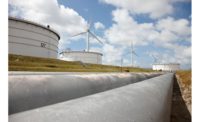Energy-efficient siting and design ensured a high level of sustainability even before the project broke ground, says Shawn Rosenberger, Turner's vice president and general manager for San Diego and the Southwest. "Because of the CM-at-risk delivery method, we were involved on conceptual design long before construction began on site."
The building is sited to maximize daylighting and minimize the need for artificial lighting. Varying-height windows, including clerestory banks, will provide a "layered" introduction of natural light. The tinted low-E glass on the west, east and south will be screened and fitted with metal eyebrows. Clear insulated glass will maximize natural lighting on the north-facing walls.
In addition, energy-efficient skylights, sized to fulfill 100% of the lumen requirements for their spaces and fitted with motorized shades, were incorporated.
Bi-level, high-efficiency light fixtures supplement daylighting for cloudy days and after dark, and LED-lighting is used extensively. Sensors automatically turn off lights in unoccupied rooms.
CMU, steel and concrete are the major building components, with considerable recycled content; except for the steel, all are locally produced. On the roof, white reflective roofing reduces heat-island effect, and, inside, nearly all materials are environmentally friendly, including fabrics for furniture coverings.
A solar heat exchanger will produce hot water in the locker rooms and the kitchen, and, outside, a water harvesting system will store rainwater for the landscaping and the athletic field to avoid pumping from the aquifer. Turner installed two 25,000-gallon water tanks, each weighing 5,600 lb, and nearly a mile of pipe. A quick payback of about five years is expected for this component, Wall says. Overall for the project, a 10-year payback is estimated.
Wall expects the school to yield 30% to 40% energy cost savings per year. That equals four full-time staff positions, says Dr. Ronda Frueauff, district superintendent. "This creates the opportunity to drive more resources down to the students for enriching the learning experience—as opposed to expending those resources on energy for operations. This accomplishment will lead to a direct impact on student achievement."
Although the school is federally funded, the sourcing did not affect the capability to reach net zero, according to the project team. More expensive components, such as photovoltaics, were secured through power purchase agreements, eliminating the need for additional school district capital.
"Our goal was to be environmentally sensitive and responsible to our community," Wall says. "Achieving net zero is not always a capital decision. Positioning your building properly to introduce daylight is not new, nor is it more costly. It's simply smart and responsible design."










